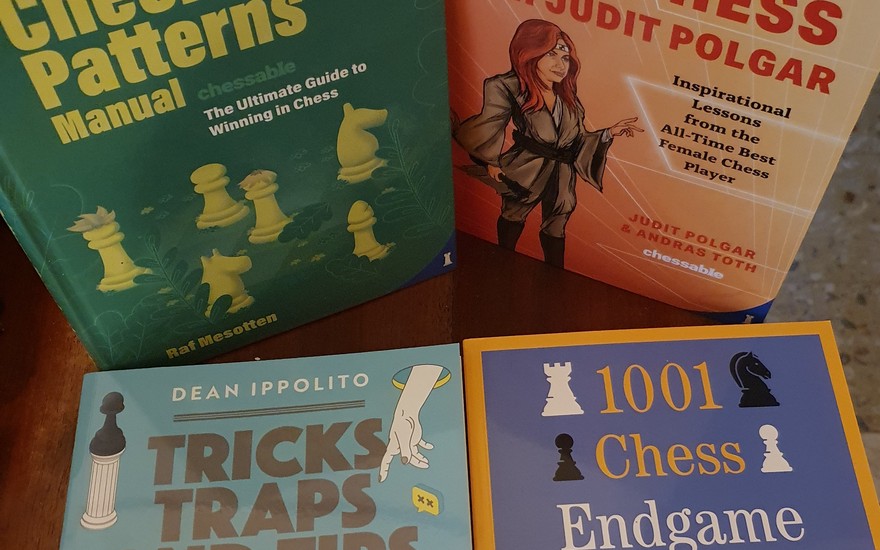
New books for improvers: review
This is a review by FM James Vigus of four recent instructional booksInstructional material for less experienced players continues to be in abundant supply. This review looks at four New in Chess titles addressing various facets of the game.
The Checkmate Patterns Manual
by Raf Mesotten
Chessable / New in Chess 2022, 374 pages
Sample pages available on the New in Chess website
Like others in the new series that converts Chessable courses into book form, this is a beautifully-produced hardback with abundant diagrams in colour, and a pleasure to open and read. The author is not a titled player, but that is not important in this case. Mesotten's work is useful, fun and well researched. Following a basic test, thirty standard checkmating patterns are introduced, with a chapter devoted to each. The second half of the book contains 1000 exercises. The examples are clear and engaging, the explanations to the point. Mesotten even provides names for the patterns, from the obvious ('back rank mate') to the intriguing ('David & Goliath mate'). Once upon a time I learnt this kind of material from Hooper and Cafferty's book Play for Mate together with Renaud and Kahn's <em>The Art of the Checkmate</em>. Both are still worthwhile, but Mesotten takes the presentation of simple checkmates to a new level.
In his fascinating recent interview on Ben Johnson's Perpetual Chess podcast, FM Carsten Hansen mentioned going through Mesotten's checkmate course on Chessable as a significant factor in his recent rating gain in online blitz, which saw him rise to 2600 and beyond. As this accolade indicates, although the book is suitable for beginners, it has a great deal to offer even at much higher levels.
In sum: highly recommended. For the sake of completeness, here is the table of contents:
007 Introduction
009 Explanation of symbols
011 EXERCISES A Basic test
024 Chapter 1 Anastasia’s mate
028 Chapter 2 Greco’s mate
037 Chapter 3 Arabian mate
041 Chapter 4 Hook mate
045 Chapter 5 Vukovic’s mate
050 Chapter 6 Smothered mate
055 Chapter 7 Suffocation mate
063 Chapter 8 Corner mate
065 Chapter 9 Morphy’s mate
068 Chapter 10 Pillsbury’s mate
072 Chapter 11 Opera mate
082 Chapter 12 Lolli’s mate
086 Chapter 13 Damiano’s mate
090 Chapter 14 Max Lange’s mate
093 Chapter 15 Damiano’s bishop mate
105 Chapter 16 Dovetail mate
115 Chapter 17 Swallow’s tail mate
121 Chapter 18 David & Goliath mate
133 Chapter 19 Boden’s mate
137 Chapter 20 Balestra mate
140 Chapter 21 Double knights mate
144 Chapter 22 Double bishops mate
152 Chapter 23 Blackburne’s mate
156 Chapter 24 Blind swine mate
158 Chapter 25 Epaulette mate
161 Chapter 26 Back rank mate
170 Chapter 27 Lawnmower mate
180 Chapter 28 Triangle mate
185 Chapter 29 Kill box mate
189 Chapter 30 Mate in the opening
197 Exercises B Warming up test
235 Exercises C Advanced test
285 Exercises D Final test
305 Solutions A Basic test
309 Solutions B Warming up test
327 Solutions C Advanced test
359 Solutions D Final test
373 Afterword
1001 Chess Endgame Exercises for Beginners
by Thomas Willemze
New in Chess 2022, 312 pages
Sample material available on the publisher's website
Subtitled 'The Tactics Workbook that Also Improves Your Endgames Skills', IM Thomas Willemze's book very clearly explains basic endgame tactics using a wealth of practical examples and 1001 exercises with thorough solutions. The idea of initially learning tactical patterns via positions with few pieces left on the board strikes me as a very good one. The approach of the book is systematic, and working through it can hardly fail to be of great benefit to an ambitious beginner. Although there is a bit of thematic overlap with Mesotten's Checkmate Patterns Manual, these two books could make a nice pair. The contents in full:
006 Explanation of symbols
007 Preface
009 Part I Basic tactical patterns
010 Chapter 1 Mate in one move
067 Test 1
070 Chapter 2 Win a piece in two moves
123 Test 2
129 Part II The preparatory move
130 Chapter 3 Mate in two moves
173 Test 3
180 Chapter 4 Win a piece in three moves
216 Test 4
225 Part III Defend
226 Chapter 5 Defend your king
239 Test 5
250 Chapter 6 Defend your pieces
261 Final Test
275 Part IV Chess Endgame Exercises for Club Players
278 Solutions
312 Bibliography
Tricks and Traps and Tips in the Chess Opening
by Dean Ippolito
New in Chess 2022, 223 pages
Sample material available on the publisher's website
Subtitled 'Practical Lessons for Ambitious Improvers', this book focuses on one tactical theme in the opening per chapter. This time let's see the contents list first:
011 Chapter 1 Early f-pawn moves
032 Chapter 2 Early queen moves
047 Chapter 3 Attack on the uncastled king
069 Chapter 4 Sacrifice on the weak spot before castling (f2/f7)
087 Chapter 5 Four Knights with 4...a6?!
102 Chapter 6 Moving the pinned piece: Legal's checkmate
124 Chapter 7 The Center Fork Trick
153 Chapter 8 The Fishing Pole
171 Chapter 9 The knight sacrifice on f7: the Fried Liver Attack
200 Chapter 10 Dueling weak spot attacks: The Traxler Gambit
215 Index of names
217 Glossary
223 Biography
The American IM and trainer offers over 200 exercises in the course of this book, usefully designed to keep the reader active. Rather than overwhelm learners with theory, he patiently and carefully provides essential knowledge about such topics as typical weak squares (f2, f7) in the opening. Illustrative games range from those by elite grandmasters to those by 'scholastic' players, including Ippolito's own students. There is a wealth of instructive material here.
On occasion there is perhaps a tendency to use a sledgehammer to bang in a nail, as in the longish chapter (5) on the opening 1 e4 e5 2 Nf3 Nc6 3 Nc3 Nf6 4 Bb5 a6?! Although this is not trivial - Akiba Rubinstein sometimes played it as Black - the problem with it can be quite quickly explained. Again, a lack of concision can diminish precision. A small example regarding the so-called Fried Liver Attack, 1 e4 e5 2 Nf3 Nc6 3 Bc4 Nf6 4 Ng5 d5 5 exd5 Na5 (the Fried Liver proper runs 5...Nxd5?! 6 Nxf7!?, as Ippolito discusses in detail) 6 Bb5+ ('This is the main move, 6 d3 is an interesting alternative', comments Ippolito - yet 6 d3 has a very bad reputation) 6...c6 7 dxc6 bxc6 8 Bd3 Be7 (p. 183): here Ippolito writes 'A move like 8...Nd5 is better'. Why not say it without the equivocation - '8...Nd5 is better'? Such reviewer's quibbles aside, however, there are some exciting highlights, as in the concluding chapter on the complex Traxler Gambit (1 e4 e5 2 Nf3 Nc6 3 Bc4 Nf6 4 Ng4 Bc5).
Master Your Chess with Judit Polgar
by Judit Polgar and Andras Toth
Chessable / New in Chess 2022, 508 pages
Sample materialon the New in Chess website, including table of contents.
This is another sumptuous Chessable hardback. Subtitled 'Inspirational Lessons from the All-Time Best Female Chess Player', it teaches the kind of dynamic, attacking, sacrificial play at which Polgar excelled. Polgar speaks in the first person in this book, though it was written in collaboration with IM Toth. As seen recently in another Perpetual Chess interview, Toth is now deservedly famous in his own right as a trainer and author.
The many examples from Polgar's games enable this large volume almost to double as a best-games collection. Games by many other players feature too, however. The regular questions in blue type prompt readers to think for ourselves. The prose explanations are impressive: despite the tactical complexity of some of the games, there are no strings of computer variations here. There are plenty of Polgar's trademark exclamations ('This position is absolutely bonkers!'). Although probably intended primarily for players below, say, 2000 elo, the book is definitely useful and fun at higher levels, too. I find many of the exercises challenging. The material is fresh, instructive and thoroughly enjoyable: this is a thoroughly successful course in grabbing the initiative in all three phases of the game. It is hard to pick out a highlight, but I loved the successive chapters on ever-larger sacrifices - of a pawn, an exchange, a piece, a rook, a queen.
More blog posts by Minckwitz

Review: Max Euwe's Best Games by Jan Timman
Games of lesser-studied world champions part 1
Review: The Perfect Pirc-Modern by Viktor Moskalenko
This is a review by FM James Vigus of Moskalenko's The Perfect Pirc-Modern
Review: Some instructional and training works
Review by FM James Vigus of recent training/calculation books